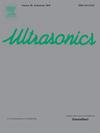An improved D-S evidence fusion algorithm for sub-area collaborative guided wave damage monitoring of large-scale structures
IF 3.8
2区 物理与天体物理
Q1 ACOUSTICS
引用次数: 0
Abstract
Due to the development of new materials and advanced manufacturing technologies, the application of large-scale composite structures has become increasingly widespread. Ensuring the safe and stable operation of such structures presents new challenges across various application domains. Addressing the limitations of existing guided wave structural health monitoring methods for online damage monitoring in large-scale structures, such as cumbersome equipment setup, insufficient signals coverage, and difficulties in processing massive data, a method for sub-area collaborative guided-wave-based structural damage monitoring and severity assessment based on sparse sensing is proposed. By employing a sparse sensing array layout, the structure is divided into multiple monitoring sub-areas with arranged sensing arrays to reduce overall complexity. The characteristic responses of the guided wave signals from different sub-areas are extracted to construct feature sub-spaces. Support vector machines are adopted to construct evaluation sub-networks in each feature sub-space, enabling regional monitoring. Additionally, an improved D-S evidence fusion algorithm is applied to fuse the decision-layer inputs from each evaluation sub-network, effectively utilizing the feature information from multiple sub-areas and enhancing the accuracy of damage severity assessment for large-scale structures. Experimental results on typical composite structure specimens demonstrate that by fusing the support vector machine evaluation results from each sub-area, the accuracy of damage severity assessment reaches 97.5%, with uncertainties in the severity assessment below 5%.
基于改进D-S证据融合算法的大尺度结构子区域协同导波损伤监测
由于新材料和先进制造技术的发展,大型复合材料结构的应用日益广泛。确保这些结构的安全稳定运行在各个应用领域提出了新的挑战。针对现有导波结构健康监测方法在进行大型结构损伤在线监测时存在设备设置繁琐、信号覆盖不足、海量数据处理困难等局限性,提出了一种基于稀疏感知的分区域协同导波结构损伤监测与严重程度评估方法。通过采用稀疏传感阵列布局,将结构划分为多个监测子区域,通过排列传感阵列来降低整体复杂性。提取不同子区导波信号的特征响应,构建特征子空间。采用支持向量机在每个特征子空间构建评价子网络,实现区域监测。此外,采用改进的D-S证据融合算法对各评估子网络的决策层输入进行融合,有效地利用了多子区域的特征信息,提高了大型结构损伤严重程度评估的准确性。在典型复合材料结构试件上的实验结果表明,通过融合各子区域的支持向量机评价结果,损伤严重程度评估的准确率达到97.5%,严重程度评估的不确定性在5%以下。
本文章由计算机程序翻译,如有差异,请以英文原文为准。
求助全文
约1分钟内获得全文
求助全文
来源期刊

Ultrasonics
医学-核医学
CiteScore
7.60
自引率
19.00%
发文量
186
审稿时长
3.9 months
期刊介绍:
Ultrasonics is the only internationally established journal which covers the entire field of ultrasound research and technology and all its many applications. Ultrasonics contains a variety of sections to keep readers fully informed and up-to-date on the whole spectrum of research and development throughout the world. Ultrasonics publishes papers of exceptional quality and of relevance to both academia and industry. Manuscripts in which ultrasonics is a central issue and not simply an incidental tool or minor issue, are welcomed.
As well as top quality original research papers and review articles by world renowned experts, Ultrasonics also regularly features short communications, a calendar of forthcoming events and special issues dedicated to topical subjects.
 求助内容:
求助内容: 应助结果提醒方式:
应助结果提醒方式:


